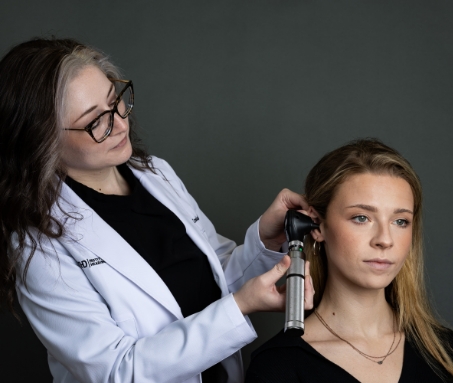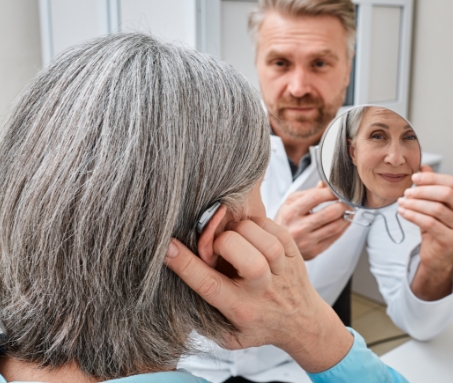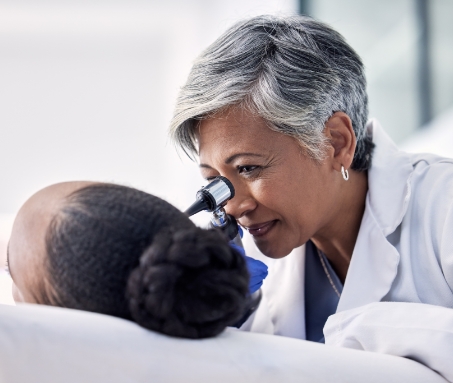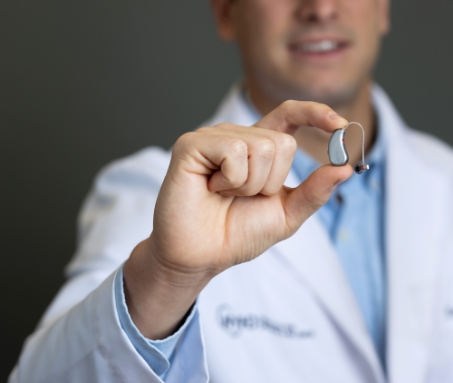We understand that quality matters most to patients. That is why we invest the necessary time and resources to achieve the best and most comfortable outcomes from the best aided-hearing technology currently available.

BEST PRACTICES AT NYHD | INSTITUTE FOR HEARING AND BALANCE
PROCESS
Using various testing to assess patients, our doctors are equipped to make appropriate recommendations to optimize successful patient outcomes and to measure hearing aid performance.
VERIFICATION
Real Ear Measurement is one of the many Best Practice procedures offered at NYHD that lead to treatment success rates significantly above the industry average.
TECHNOLOGY
NYHD doctors will work to fit your hearing aid based on concrete scientific data as well as one-on-one discussion and in-the-moment adjustment to create the best possible hearing aid output for your specific loss and personal preferences.
Our Hearing Aid Fitting Process

Comprehensive Audiological Evaluation +
A successful hearing aid fitting begins with a thorough understanding of each patient’s current auditory status using the Blueprint Method. A standard complete audiological evaluation, consisting of air and bone conduction threshold, speech threshold, and word recognition tests is performed, but we opt for additional testing to prepare for the real-life circumstances in which our patients plan to hear.
listening-in-noise ability test
The chief complaint of many patients is difficulty hearing a nearby speaker in the presence of background noise. That’s why at NYHD, this additional test assesses each patient’s listening in noise ability creating a clearer picture of how we can support our patients in all environments.
upper loudness tolerance test
Additionally, the upper loudness tolerance of each patient’s hearing must be carefully measured in order to provide a comfortable and safe experience for potential hearing aid candidates. These will serve as “hard stop” levels that hearing aids will be programmed to never exceed, a reassuring fact for our patients familiar with the dynamic soundscape of New York; a well-fit hearing aid will amplify in the way you need help, but this test prevents us from over-assisting with the available technology.

Best Practices Guide our Hearing Aid Fittings
Should you and your doctor agree that hearing aids are the best solution for you, you’ll begin a process defined by best practices that exceed minimum requirements and focus on helping you make the most of your hearing; this will happen over a series of carefully structured visits.
OUR NYHD 45-day Fitting SEQUENCE
This includes a carefully planned set of four appointments, allowing ample time for you and your audiologist to work together to maximize the efficacy of your devices. This period of fitting and programming is one of the most crucial stages in your treatment, as it requires precise adjustments tailored to your specific hearing needs. Many measurements and assessments will be performed during this period, which can be broken down into 3 categories: Objective Measurements, Subjective Assessments, and Aided/ Functional testing.
Objective Measurements
Electroacoustic analysis of hearing instruments
Probe microphone measurements
Real Ear Measurements to verify device output
Subjective Assessments
Client Oriented Scale of Improvement (COSI)
Profile of Hearing Aid Benefit (APHAB)
Tinnitus Handicap Inventory (THI)
Tinnitus Functional Index (TFI)
Functional testing
Pure tone thresholds
Speech audiometry
Listening in noise
By the end of your 45-Day Best Practice Fitting sequence, you will have a clear understanding of how well you can hear the world with your hearing aids. We measure and verify every component of your hearing treatment to ensure a high quality, consistent hearing experience for years to come.
The Importance of Real Ear Measurements

Real Ear Measurement (REM)
To truly hear your best with your hearing aids, they need to be programmed using Real Ear Measurement (REM). REM is a verification method performed by our Doctors of Audiology to ensure your hearing aids meet your specific hearing loss prescription for the required amplification.
THE REM PROCESS
During REM, our audiologists place probe microphone tubes inside your ears to measure the actual amplification you are receiving from your hearing aids.
Then, they adjust the manufacturer programming software to precisely match your prescriptive targets.
Individuals whose hearing aid programming is verified with Real Ear Measurement not only perceive better sound quality but also understand speech significantly better in both quiet and noisy environments.
The Technology

Improving Communication In A Variety Of Settings
The hearing aid technology plays a critical role in the process of rehabilitating a patient’s hearing loss and in having a successful hearing aid fitting process. Our Doctors of Audiology remain at the forefront of hearing aid technology developments and offer a wide range of solutions that are tailored to each patient’s individual needs.
selecting the right device
The appropriate style of hearing aid is dependent upon patient preference, patient goals, and a variety of factors related to hearing loss and the anatomy of your ear.
The style of the hearing aid will determine whether the hearing aid is rechargeable or battery powered, whether there is user control and connectivity to the hearing aid, availability of directional microphones, compatibility with assistive listening, ease of handling the devices, as well as visibility of the hearing aids. Not all types of hearing aids support all kinds of hearing loss; your doctor will help narrow your options to what’s appropriate for you.
Once you’re fit with your devices, we’ll see you at three subsequent visits for refinement of our original programming.. Our team loves to see excellent outcomes, and we look forward to working with you and for you on your hearing journey.
Latest Google Reviews
How often should I have my hearing tested?
Can hearing aids help with tinnitus?
Are hearing aids waterproof?
How long does a hearing aid battery typically last?
Can I sleep with my hearing aids in?
How do I clean my hearing aids?
Can hearing aids connect to my smartphone?
How long does it take to adjust to new hearing aids?
Are there different programs in hearing aids for different environments?
How often should I have my hearing aids professionally cleaned and checked?
How can I tell if Im experiencing hearing loss?
Can hearing loss be prevented?
Is hearing loss always permanent?
Can stress cause hearing loss?
Are there different types of hearing loss?
Can hearing loss affect balance?
Is hearing loss hereditary?
Can certain medications cause hearing loss?
How does noise-induced hearing loss occur?
WE CAN HELP
Contact us to learn more or schedule a consultation.